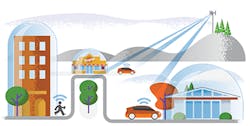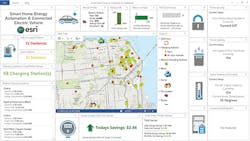(Sponsored Content) The number is impressive! It is estimated that there will be over 20 billion installed IoT devices by 2020. So why should we embrace a connected world, and why is location important?
The Promise
IoT promises to leverage technology to create a safer, simpler, and more eco-friendly world. With everything connected, it will be possible for applications to, without human intervention, automatically adjust lights, reset thermostats, and activate security systems, based on our needs. However, delivering these benefits will require more than just connecting devices and building apps. It will necessitate the construction of a new IoT ecosystem. Essential elements will include device management, communications, intelligent gateways, analytics, applications, and, most importantly, location. Each IoT device acts as a sensor collecting data. Turning this data into actionable intelligence requires knowing where the data was collected.
Now imagine a connected world where you wouldn’t have to worry. As you back out of the driveway, your smart home is aware of your departure, thanks to geofencing or a virtual perimeter. It also knows you forgot to turn off the lights, set the alarm, and lock the door. Since it doesn’t sense anyone else in the house, it does these chores for you. If you leave work early, the home would be prepped for your arrival — fully lit with the temperature at a comfortable setting. The added benefit is that your power consumption for the day would be minimized, based on your actual movements. All settings would be automatically based on your location, and the potential applications are limitless.
These are just the very basic ways the connected world improves your life. Imagine an entire smart city. An app would tell you when the next bus or train is coming in real time, not just based on the daily schedule. If you drive, your connected car could direct you to the nearest open parking spot, saving time and fuel. Similarly, smart appliances could make brownouts a blight of the past by controlling millions of high-consumption devices during peak demand. The possibilities are limitless.
About the Company: ArcGIS Software/Esri is the world leader in delivering a geographic information system (GIS) technology that enables enterprises of all sizes to think, analyze, and act geographically. The ArcGIS solution eliminates silos by connecting all the departments in an organization using an industry-standard, location mapping and geospatial analysis platform. Esri’s solutions for the Telecommunications industry provide on-screen, real-time visual information to effectively assess, plan, engineer and track network projects. Companies can access and share data through a single GIS platform enabling enhanced market forecasts and analysis, network planning, service coverage maps, field crew routing and network analysis. Whether you require a custom solution for your enterprise or need enhanced engineering tools, Esri has a platform to meet every need. For additional information on Esri’s solutions for Telecommunications visit www.esri.com/OpIntel.
Save
Save
About the Author



